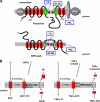Intramembrane proteolysis by signal peptide peptidases: a comparative discussion of GXGD-type aspartyl proteases
- PMID: 19189970
- PMCID: PMC2682845
- DOI: 10.1074/jbc.R800040200
Intramembrane proteolysis by signal peptide peptidases: a comparative discussion of GXGD-type aspartyl proteases
Abstract
Intramembrane-cleaving proteases are required for reverse signaling and membrane protein degradation. A major class of these proteases is represented by the GXGD-type aspartyl proteases. GXGD describes a novel signature sequence that distinguishes these proteases from conventional aspartyl proteases. Members of the family of the GXGD-type aspartyl proteases are the Alzheimer disease-related gamma-secretase, the signal peptide peptidases and their homologs, and the bacterial type IV prepilin peptidases. We will describe the major biochemical and functional properties of the signal peptide peptidases and their relatives. We then compare these properties with those of gamma-secretase and discuss common mechanisms but also point out a number of substantial differences.
Figures


Similar articles
-
Intramembrane proteolysis of GXGD-type aspartyl proteases is slowed by a familial Alzheimer disease-like mutation.J Biol Chem. 2008 Oct 31;283(44):30121-8. doi: 10.1074/jbc.M806092200. Epub 2008 Sep 3. J Biol Chem. 2008. PMID: 18768471 Free PMC article.
-
Substrate requirements for SPPL2b-dependent regulated intramembrane proteolysis.J Biol Chem. 2009 Feb 27;284(9):5662-70. doi: 10.1074/jbc.M807485200. Epub 2008 Dec 29. J Biol Chem. 2009. PMID: 19114711
-
Signal Peptide Peptidase-Type Proteases: Versatile Regulators with Functions Ranging from Limited Proteolysis to Protein Degradation.J Mol Biol. 2020 Aug 21;432(18):5063-5078. doi: 10.1016/j.jmb.2020.05.014. Epub 2020 May 26. J Mol Biol. 2020. PMID: 32464132 Review.
-
Regulated intramembrane proteolysis of Bri2 (Itm2b) by ADAM10 and SPPL2a/SPPL2b.J Biol Chem. 2008 Jan 18;283(3):1644-1652. doi: 10.1074/jbc.M706661200. Epub 2007 Oct 25. J Biol Chem. 2008. PMID: 17965014
-
Intramembrane proteolysis by presenilin and presenilin-like proteases.J Cell Sci. 2003 Jul 15;116(Pt 14):2839-44. doi: 10.1242/jcs.00651. J Cell Sci. 2003. PMID: 12808018 Review.
Cited by
-
QARIP: a web server for quantitative proteomic analysis of regulated intramembrane proteolysis.Nucleic Acids Res. 2013 Jul;41(Web Server issue):W459-64. doi: 10.1093/nar/gkt436. Epub 2013 May 31. Nucleic Acids Res. 2013. PMID: 23729472 Free PMC article.
-
Covalent fragment inhibits intramembrane proteolysis.Front Mol Biosci. 2022 Sep 7;9:958399. doi: 10.3389/fmolb.2022.958399. eCollection 2022. Front Mol Biosci. 2022. PMID: 36158579 Free PMC article.
-
A Single-Cell Platform for Monitoring Viral Proteolytic Cleavage in Different Cellular Compartments.Biochem Insights. 2016 Sep 22;8(Suppl 2):23-31. doi: 10.4137/BCI.S30379. eCollection 2015. Biochem Insights. 2016. PMID: 27688710 Free PMC article.
-
The α-helical content of the transmembrane domain of the British dementia protein-2 (Bri2) determines its processing by signal peptide peptidase-like 2b (SPPL2b).J Biol Chem. 2012 Feb 10;287(7):5156-63. doi: 10.1074/jbc.M111.328104. Epub 2011 Dec 22. J Biol Chem. 2012. PMID: 22194595 Free PMC article.
-
Rip exposed: how ectodomain shedding regulates the proteolytic processing of transmembrane substrates.Proc Natl Acad Sci U S A. 2009 Sep 1;106(35):14737-8. doi: 10.1073/pnas.0908124106. Epub 2009 Aug 26. Proc Natl Acad Sci U S A. 2009. PMID: 19717451 Free PMC article. No abstract available.
References
-
- Wolfe, M. S., and Kopan, R. (2004) Science 305 1119–1123 - PubMed
-
- Brown, M. S., Ye, J., Rawson, R. B., and Goldstein, J. L. (2000) Cell 100 391–398 - PubMed
-
- Kopan, R., and Ilagan, M. X. (2004) Nat. Rev. Mol. Cell Biol. 5 499–504 - PubMed
-
- Haass, C., and Steiner, H. (2002) Trends Cell Biol. 12 556–562 - PubMed
Publication types
MeSH terms
Substances
LinkOut - more resources
Full Text Sources
Other Literature Sources

